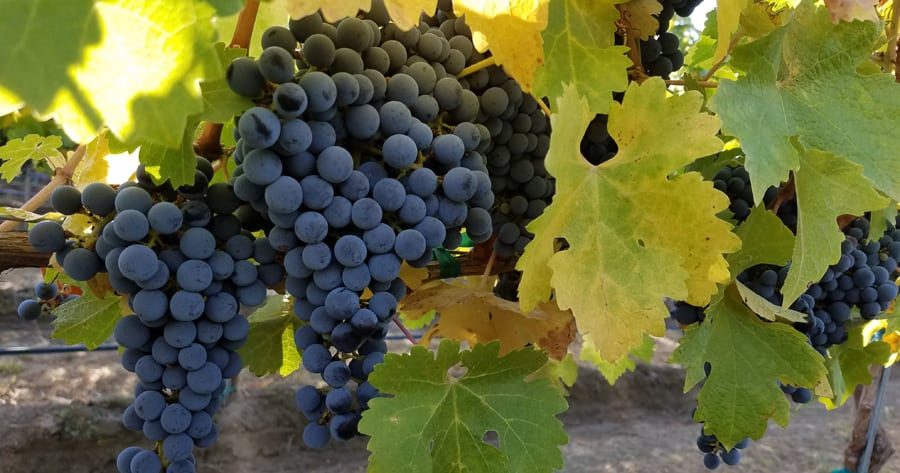
Home » Veraison signals upcoming harvest for growers, winemakers
Veraison signals upcoming harvest for growers, winemakers

August 20, 2018
By David Forsyth
Verasion is the harvest wake-up call for wine-grape growers and winemakers. The sign to get the harvester ready and the vats empty for the coming harvest. Verasion is the point of development where the berry starts to soften and plump and the fruit is making the final lap to maturity. For a white
grape, the color moves from an opaque pea green to a translucent lime and the red grape starts to color up – turning burgundy red. The sugar is still quite low and the grape acid high but with each warm day the sugar rises, the acidity drops and the flavors begin to develop as the fruit ripens.
This is also the time we evaluate and act, as necessary, on our crop estimates that were completed in late July. In evaluating the crop, the grower has come to know what the potential or target yield (tons/acre or pounds/vine) is for a particular block after years of farming and harvesting the fruit.
A typical target crop load may be four to seven tons per acre depending on the site and variety. If a crop estimate indicates that the crop is around six tons per acre and the target is five tons per acre you will need to thin one ton per acre of grapes onto the ground. Additionally, if we have been experiencing a much cooler than normal growing season you may want to lower that target down to about four tons per acre to ensure that the fruit ripens.
Conversely if you have a warmer vintage, you will feel confident that you will be able to ripen your fruit and get it into the winery a week or so earlier than usual. Once you have made the decision to drop some excess fruit, you will send a hand-crew out with instructions to drop a defined amount of clusters per vine.
Up until now the grower has been utilizing deficit irrigation of the vines where less than 100 percent of the water the vine is using daily is being replaced. Deficit irrigation is used to help control the size of the berry and the canopy. At this point of the season we can start watering them a bit more to keep the vines healthy and allowing the fruit to mature without undue stress.
Soon we will start grape sampling in the early ripening varieties: Sauvignon Blanc, Pinot Gris and Chardonnay, from warm sites. These will be the first grapes to ripen and be harvested. Early on we will sample these blocks weekly, walking the vineyard and pulling a cluster here and there from different vines and from different areas from within the canopy to come up with a representative sample from that vineyard.
In all, 30 to 40 clusters per block are pulled and taken to the winery where they are crushed and analyzed for sugar (brix), total acidity (TA) and pH. It is important that the juices are tasted by the winemakers to check for flavor development.
Brix is a pretty good indicator of ripeness and is important as the starting sugar in the pressed juice will dictate what your final alcohol will be as the yeast convert sugar to alcohol. The higher the starting sugar the higher the final alcohol. Alcohol levels have a lot to do with defining style, mouthfeel and richness of a wine. Too little and the wine is thin; too high the wine is hot; but just right, the wine has body and sweetness. TA and pH also are important as they will give the wine brightness and mouth-watering acidity.
But it is the flavor that trumps all. Like any fruit, you have a range of ripeness from under-ripe to ripe to over-ripe and you have different shades or qualities of flavors at each stage of ripeness. You may go from grapefruit to melon to fig in the same block as the fruit ripens. These flavors coupled with the final alcohol and TA will define the style of the finished wine. It is not unusual for a vineyard to be picked over several weeks as the grapes go to different wineries. The winemakers are going for different styles of wine; one perhaps more refined, bright and refreshing while another is looking for a riper more opulent style.
In the winery, we start to prepare in earnest once we see verasion. We continue to bottle to empty tanks for the upcoming fruit. We start receiving our harvest supplies such as yeast and yeast nutrients which will be added to the juice to ferment the wine. We also are bringing in new barrels and if we are lucky a new pump or two to help move the juice and wine from tank to tank. We also are hiring and training harvest cellar workers. Our staff triples for harvest as we will be working seven days a week and running 24 hours a day to get the fruit in and the work done.
Harvest starts up in late August now. It used to be first or second week of September. This is due to climate change with our growing season starting earlier now and we have warmer summer days.
Harvest is an exciting time. Always welcomed with a bit of dread recognizing the work load about to be inflicted, but also anticipation of this year’s harvest and what makes it different from every harvest before - the weather, the wine, the people. They all come together to make something special.
David Forsyth is the winemaker and general manager of Four Feathers Wine Estates in Prosser.
Local News
KEYWORDS august 2018






